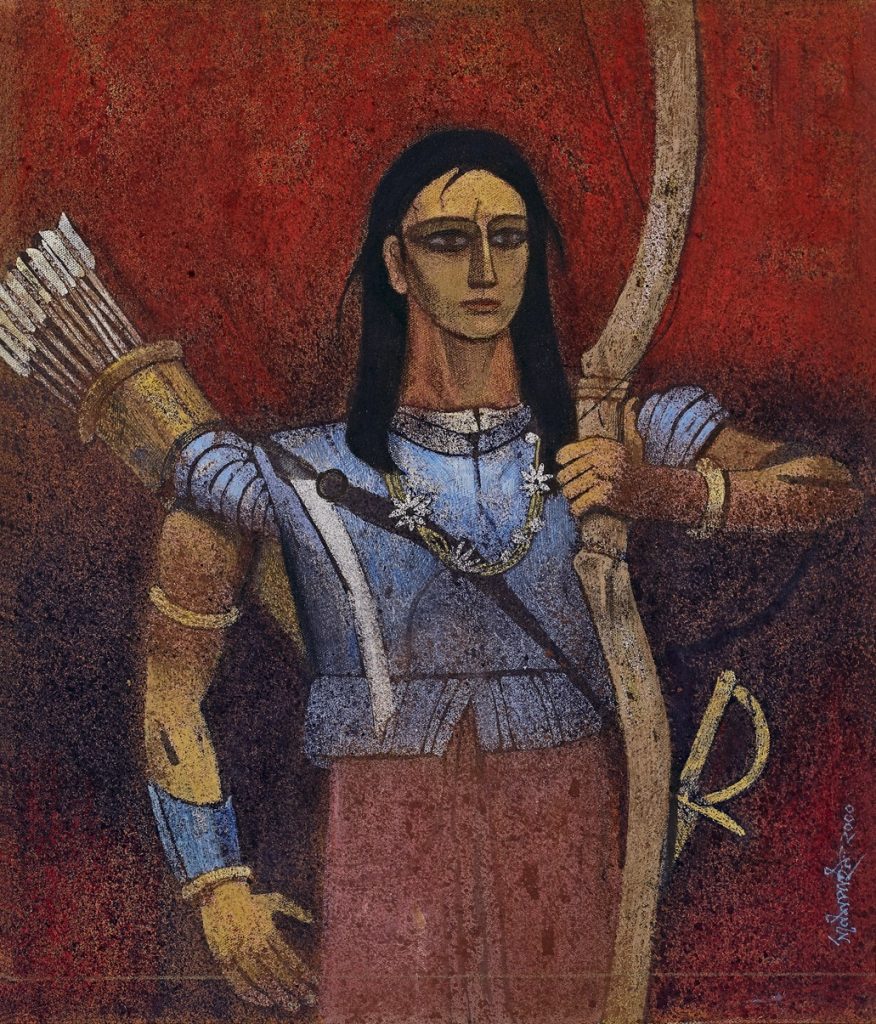The epic as final solution
Published @ Bengal Post

Abhimanyu by Ganesh Pyne.
Mahabharata is not just full of both heroic as well as cowardly narratives but also possibilities. Incidences. Psychologies. Archetypes. Totems. Guilt. And of course tragedy. And for an artist, poet, author, the beauty of Mahabharata lies in its complexity, in its secret histories, it’s annals of beginnings and ends, of trials and dénouement, and an incessant preoccupation with death.
Ganesh Pyne — perhaps the last of the earlier generation of greats from this part of the globe who is still active in his art, is known as a chronicler of darkness for his inexorable interpretations of the nocturne. For decades now, Pyne, who has been a keen student and admirer of the iconic Swiss expressionist painter and printmaker Paul Klee (along with Hals Rembrandt), has put in canvass silent, somnolent but unremitting meditations on death, hunger and pain, meditations that make his painting poignant and full of the inevitability of finality.
He had to turn to Mahabharata. And in his new solo currently on view at CIMA, he has done so, with almost perfect effect. Pyne’s Mahabharata, haunting and revelatory, will make it clear that Mahabharata survives, like Shakespeare’s plays, because of its gift of reinventing itself. Its openness is seductive; its interpretive possibilities are endless. And Pyne, like a true artist, has extolled the cultural eclecticism, the disturbing moral ambiguity and the haunting poetry of death, to great, if not exhaustive, effect. An effect that is sure to remind one of Horace’s Ut Pictura Poesis. Or Fyodor Dostoevsky. Or Anatole France. Or Jean Anouilh.
It is impossible to do the whole epic and Pyne has rightly chosen and handpicked incidents. Some, like the death of Krishna from bleeding in his heels, a lonely, resigned Arjuna at the war or Bhisma on his bed of arrows are simple and short of impact. Clearly, Pyne is at home not in portraits but in conflicts, in issues, in a critique. In one of the most startling paintings, Shakuni is shown having pale, alabaster hands and white, unmarked eyes — impossible to look at straight — while he is playing the dice with Yudhistir. In another painting, Krishna is a towering shadow when he shows the universe to Arjun. A key and friendly figure otherwise, Krishna becomes the universe incarnate, the implausible, imperceptible shadow. When Draupadi is stripped in public, she first prays to Krishna and then to Dharma. Pyne interprets Dharma as Jagganath, the dark God. In the painting, Jagganath leans over the entire scene as if in jest, while Draupadi’s clothes are pulled away. The drawing of Ganesh as the amanuensis of the great poet Vyasa deserves special mention. As if Ganesh the painter is also Ganesh the writer of the epic — the arch-interpreter, the proto-chronicler. Incidentally, the portrait of Ganesh is clearly influenced by Peter Brook as are most of the costumes in the paintings, an influence that Pyne mentions while insisting that the need to look at Brook is not just artistic but also historical.
But Pyne is too much of a master of his craft to dwell too long on influences. If Ganesh is from Brook, the painting of Kali dancing lustily at the scene of war filled with corpses and severed heads is very much the incandescent Bengali at work. So is Yudhistir’s final pray on the heap of skulls — keenly reminiscent of tantric traditions — before he embarks on his journey to Heaven through Hell. In fact, his tour of Hell is fascinatingly depicted as him being swarmed by a gigantic skull and somehow one finds the word skullduggery full of possibilities when confronted with such a vision of Hell. This vision is all the more poignant in The Demon and more crucially in The Torch – two phantasmagoric works that are also disturbing critiques of war and power.
In a recent interview, Pyne had said that among other things, Mahabharata is like a book of endings, a book that shows how the cardinal law of the universe is the atomization of soul, body, mind and matter; how our greatest tragedy is to see everything around us coming to an end. Pyne’s Mahabharata will surely leave one with an excruciating whimper of The Final Ending, even if it falls just a little short, a little short of the howl of despair.
comments for this post are closed